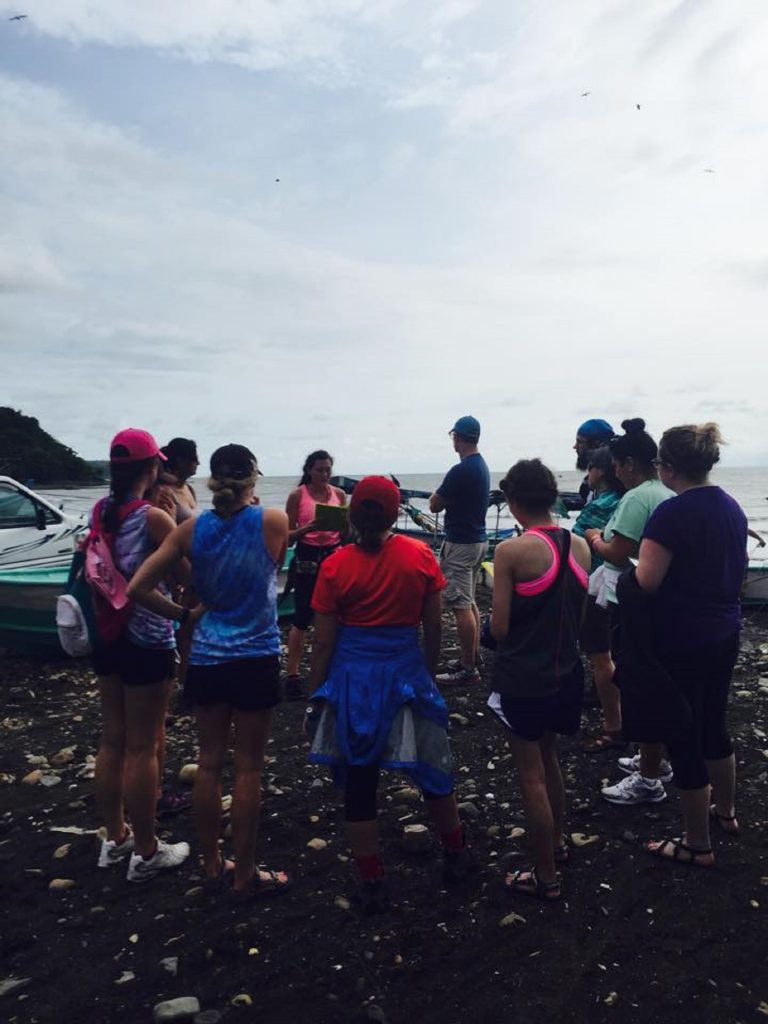A dark roll of rain clouds perched below a hazy sky, prepared to swoop down and release sorrow onto the black, pebbled beach below. Weathered fishermen scrambled to make swift decisions about food and family; some hunkered down in their boats for the evening, others relentlessly pushed their small vessels into the crashing waves. Decisions about food for you and me; choices that lead to food on the tables of their families.
I stood where the Pacific Ocean meets the volcanic land, seemingly out of place. I’m not sure if it was my notebook or camera that gave me away, or, perhaps, the fluorescent orange shirt, gray cabana shorts, flip-flops, and Wayfarers. At any rate, there I was: part voyeur, part researcher, all parts tourist. Or should I say, there we were.
I wasn’t alone.
I stood on the beach in Camaronal, Costa Rica, with eleven other Americans, and, of course, the fishermen of Costa Rica. We watched with admiration as these choices unfolded before our eyes. We listened as Regan—a 20-year-old from Rushville, Indiana—explained the effects of the American palate on fishing in the area; we nodded as she discussed Co-Ops and how they are better for the fishermen and their families.
Voyeurs, researchers, tourists, and students, all learning among man and land. Weary from the truths witnessed; forever changed by the experience. The lives of fellow humans; the purchases we make.
***
I traveled to Costa Rica with my friend and colleague, Kelsey Timmerman. Our trip to the Land of Ticos had a few purposes.
For starters, EARTH University in Guacimo is leading the first international Facing Project and they asked us to come to campus for a few days to discuss how the project can be embedded within the curriculum. After four days at EARTH, we met up with a group of Ball State University students who studied sustainable agriculture and eco-tourism in the area; all of whom had read Kelsey’s book, WHERE AM I EATING? A JOURNEY THROUGH THE GLOBAL FOOD ECONOMY. From there, we traveled with them for seven days to explore pineapple, banana, coffee, chocolate, heart of palm and fish farms, and studied the impact—good and bad—farming can have on the environment and the people who grow our food.
Each student studied a different crop; researching the history and production prior to their immersive experience in Costa Rica. During our travels across the country, we saw first-hand the devastation caused by conventional farming: clear-cut rain forest, harsh chemicals, and long hours with low pay. We saw opportunity created by Co-Ops and sustainable farms that are improving the lives of some Costa Ricans, the environment, and the crops that land in our supermarkets and ultimately into our bellies.
From farm to farm, discussion to discussion, the students started to make connections to literature that played out in real time before their eyes. They asked tough questions: But if the conventional farms shut down, what would happen to the workers and their families? Or as Kelsey often says, “Is it exploitation or opportunity?”
That question isn’t always easy to answer. On the surface, it may seem that shutting down conventional farms is the way to go. But the reality, in some instances, is those farms are the only means toward a future for some of the farmers. The sad truth is that the companies could decide to leave on their own accord, and there’s nothing left for the families.
It’s a double-edged sword.
Conversations with the students led to discussions on the power we each bring to challenging topics and situations. In my and Kelsey’s case, we both write and use The Facing Project as a model to create community conversations to inspire others to use their powers to make a difference. For a student who desires agriculture as a future career, he/she has the power to choose the way their company is organized and how workers are treated. As consumers, we can all use our spending power to make a difference.
As an educator, the most powerful take away from all of the conversations was an affirmation that community-based educational experiences work. Even though I’ve been in higher education for nearly 15 years, 10 of which has been with Campus Compact, I rarely get the direct opportunity to travel with students for multiple days to see the learning in and with the community first hand. For me, as a life-long student, I had the chance to marry the literature—the gospel of community engagement that I so often preach—to the real-time. A validation that learning can certainly occur within the four walls of classroom on a campus, but it’s in the field where we see real transformational learning happen—and happen fast.
Not only for students, but for teachers as well.
***
Wiping sleep from my eyes, I stumbled through the front door of my home in Muncie, Indiana. Doggy kisses and squeals greeted me; a warm welcome after eleven long days on the road. My husband Cory stood beyond the threshold, a smile upon his face to express without words his happiness that I’d returned. Hungry and tired, I decided on something light.
“Maybe just a banana,” I whispered in my mind.
Perched upon the countertop, a stalk of bananas. “Dole: Product of Costa Rica.”
I stared at the bananas for a moment, reflecting on my time there; thinking about the conventional plantations we saw. Maybe these bananas were not just a product of Costa Rica but a product of the places I’d been and the people I’d met.
“Opportunity or exploitation?” I stripped back the peel and took a bite.
“Tomorrow,” I thought, “tomorrow I’ll buy organic.”


